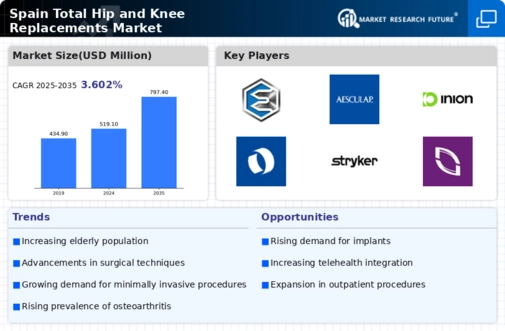Rising Healthcare Expenditure
Spain has witnessed a steady increase in healthcare expenditure, which is a crucial factor influencing the total hip-knee-replacements market. In recent years, healthcare spending has grown by approximately 5% annually, reflecting the government's commitment to improving healthcare services. This increase in funding allows for better access to advanced surgical procedures and technologies, thereby enhancing patient outcomes. Furthermore, the Spanish healthcare system is increasingly prioritizing orthopedic surgeries, which is likely to drive the demand for hip and knee replacements. As a result, the total hip-knee-replacements market is expected to benefit from this upward trend in healthcare investment.
Growing Awareness of Joint Health
There is a notable increase in public awareness regarding joint health and the benefits of surgical interventions, which serves as a significant driver for the total hip-knee-replacements market. Educational campaigns and community health initiatives in Spain have contributed to a better understanding of joint disorders and available treatment options. As individuals become more informed about the potential for improved mobility and quality of life through hip and knee replacements, the demand for these procedures is likely to rise. This heightened awareness is expected to translate into increased consultations with orthopedic specialists, further propelling the total hip-knee-replacements market.
Advancements in Surgical Techniques
Innovations in surgical techniques, particularly minimally invasive procedures, are transforming the landscape of the total hip-knee-replacements market. These advancements not only reduce recovery times but also minimize complications associated with traditional surgeries. In Spain, the adoption of robotic-assisted surgeries and enhanced imaging technologies has gained traction, leading to improved precision and outcomes. As more healthcare facilities incorporate these advanced techniques, patient satisfaction is likely to increase, further driving demand for hip and knee replacements. The total hip-knee-replacements market is poised to benefit from these technological advancements, which may lead to a broader acceptance of surgical interventions.
Increased Availability of Advanced Prosthetics
The total hip-knee-replacements market is significantly influenced by the availability of advanced prosthetic devices. In Spain, manufacturers are increasingly focusing on developing high-quality, durable, and biocompatible materials for joint replacements. Recent innovations have led to the introduction of prosthetics that offer improved functionality and longevity, which is appealing to both patients and healthcare providers. As the market for these advanced devices expands, it is expected that more patients will opt for hip and knee replacements, driven by the desire for better performance and reduced revision rates. This trend is likely to enhance the overall growth of the total hip-knee-replacements market.
Aging Population and Increased Incidence of Joint Disorders
The aging population in Spain is a primary driver for the total hip-knee-replacements market. As individuals age, the prevalence of joint disorders such as osteoarthritis and rheumatoid arthritis tends to increase. According to recent statistics, approximately 30% of the Spanish population aged 65 and older experiences some form of joint pain, leading to a higher demand for surgical interventions. This demographic shift is expected to continue, with projections indicating that by 2030, the number of individuals over 65 will rise to 25% of the total population. Consequently, the total hip-knee-replacements market is likely to expand significantly as healthcare providers seek to address the needs of this growing segment.






















Leave a Comment